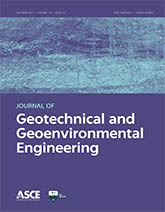Combined Effects of Soil Stress History and Scour Hole Dimensions on Laterally and Axially Loaded Piles in Sand and Clay under Scour Conditions

Zhang, Y., and Tien, I., “Combined Effects of Soil Stress History and Scour Hole Dimensions on Laterally and Axially Loaded Piles in Sand and Clay under Scour Conditions,” ASCE Journal of Geotechnical and Geoenvironmental Engineering, Vol. 148, No. 5, May 2022
Abstract — Removal of soil around a bridge foundation due to scour results in a reduction of the lateral and vertical foundation capacity due to the loss of soil support. Thecommon approach in modeling the scour phenomenon of removal of soil springs without modifying the parameters of the remaining soil fails to consider the change of stress state of the remaining soil and the formation of scour hole geometry around the pile foundation. In practice, both of these factors impact the mechanical properties of the remaining soil and the resulting expected structural response of the pile under loadings. This paper proposed a methodology to comprehensively evaluate the combined effects of stress history and scour hole dimensions on piles under scour conditions in uniform soil. It enabled the examination of the lateral and axial behaviors of a loaded pile subject to scour and is applicable for both cohesive and cohesionless soils. The methodology was validated with results from field tests for no-scour scenarios and verified with existing numerical models for scour scenarios. Quantification of the soil effects was investigated through lateral pile deflection and load-settlement curves for lateral and axial behaviors, respectively. Load-settlement curves demonstrated that including the effect of stress history results in increases of up to 34.1% and 61.1% in estimated pile settlement for sand and clay, respectively, leading to potential unconservative designs if soil effects are not properly included in the analysis.
Leave a Reply